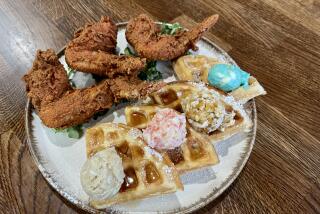Our Daily Spread : E Pluribus Chunky : American History: The spread made from “goober peas” was no overnight sensation. It took an ex-slave scientist and inventor to develop peanut butter’s potential.
- Share via
The United States is the peanut-butter-eatingest nation in the world. In most countries, peanuts are basically a source of oil (it’s estimated one-sixth of the world’s vegetable oil comes from peanuts). In our country, though, only a small fraction of the peanut crop goes for oil. Most of the rest turns into good old smooth or crunchy.
It wasn’t always this way. Until late in the 19th Century, only the poorest people in the South ate peanuts, and they ate them boiled or fried, not spread on bread with jelly. Of course, some people consumed peanuts without realizing it--in the form of Smithfield ham, which is made from hogs fattened on peanuts.
But a taste for peanuts grew, supposedly because soldiers on both sides of the Civil War had sometimes been reduced to eating “goober peas.” In the 1880s, P. T. Barnum started selling roasted peanuts at his circuses, and for a long time peanuts were associated with seeing (and feeding) elephants. Roasted peanuts gradually became a familiar snack food. By the middle of the 1890s there were peanut-roasting wagons on city streets.
Peanut butter had been invented (as far as this country is concerned) in 1880 by a St. Louis physician who wanted a high-protein food to prescribe for his patients. It was being made commercially by 1890, but it wasn’t exactly an overnight sensation. In 1899 there were still only two companies making it.
*
In 1896, when the ex-slave scientist/inventor George Washington Carver began exploring new uses for the peanut, it wasn’t even a recognized commercial crop. One thing that got Carver interested in the peanut was its potential for reversing the soil depletion that had resulted from the over-planting of cotton in the South. Peanuts, which belong to the legume family, actually add nitrogen to the soil.
Carver made the nation peanut-conscious, dazzling people with the hundreds of uses he found for “the humble goober.” He created inks, plastics, linoleum, cosmetics--altogether about 300 products. And he stressed the nutritional value of peanuts, especially their high protein content. In 1912, Good Housekeeping was publishing a few peanut recipes (peanut and rice pilaf, peanut sauce for turkey, a peanut omelet, peanut canapes).
A patent had been granted for a commercial peanut grinding machine in 1903. By 1914, there were several dozen brands of peanut butter--most of them, however, with only local distribution because peanut butter didn’t keep well. The oil quickly separated out, and stirring it back in was a strenuous job. Peanut butter turned rancid pretty quick too.
Peanuts got an official boost from Washington during World War I, when the wartime Food Administration popularized the latest nutritional discoveries, such as protein and vitamins, as part of a program of encouraging people to conserve food. As the result of all the publicity from Carver and the Food Administration, Americans came to think of protein-rich peanut butter as a particularly suitable food for growing children.
*
So for generations, the grammar school cloakroom was a place lined with grease-stained paper bags wafting the mingled scents of peanut butter and tuna salad sandwiches. Peanut butter sandwiches acquired a nostalgic charm impossible for non-Americans to understand--just as we find it impossible to understand the appeal of the Australian sandwich spread Vege-Mite, also originally a health food.
With the introduction of improved technology such as hydrogenation and stabilizers, the keeping qualities of peanut butter improved and national peanut brands started to emerge. In 1927, J. L. Rosenfield Packing Co. of Alameda, Calif., licensed its process for making smoother-textured peanut butter to E. K. Pond of Chicago, which made Peter Pan. In 1932, Rosenfield canceled the agreement and started marketing its own brand, Skippy. Skippy’s chunky-style peanut butter was introduced in 1935. Peanut butter as we know it from the supermarket shelf had started to take shape.
However, in some other countries there are styles of peanut butter that haven’t caught on here yet. In Haiti, there’s a peanut butter flavored with hot pepper known as mamba. The Ijaw of Nigeria grind their smoked peanuts--and mix them with smoked fish for a sort of canape.
And in Indonesia, peanut butter is fermented like tempeh , the Indonesian version of soybean tofu. Peanut butter tempeh is served fried, by the way.
More to Read
Sign up for Essential California
The most important California stories and recommendations in your inbox every morning.
You may occasionally receive promotional content from the Los Angeles Times.













